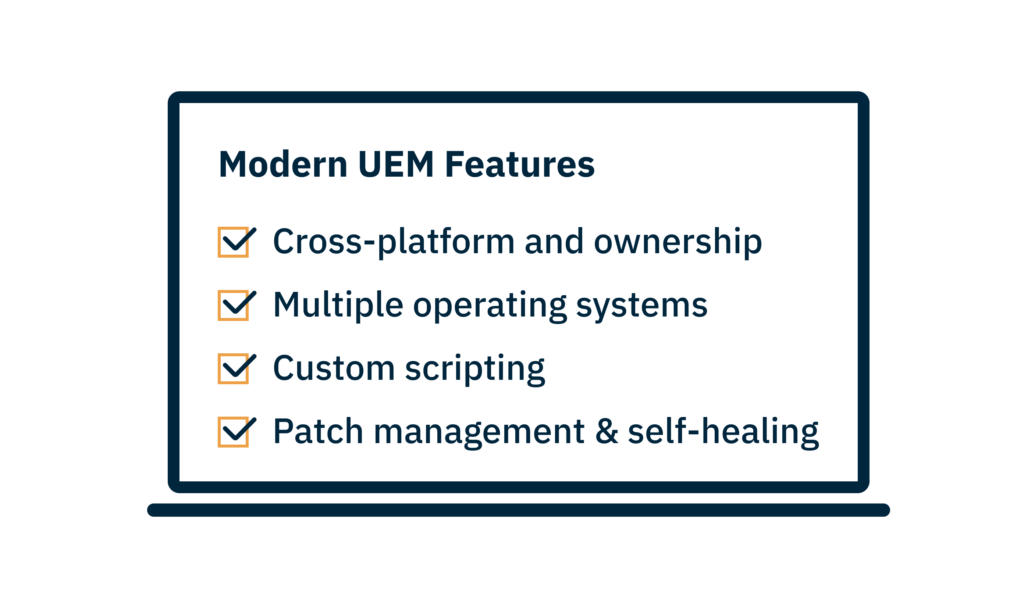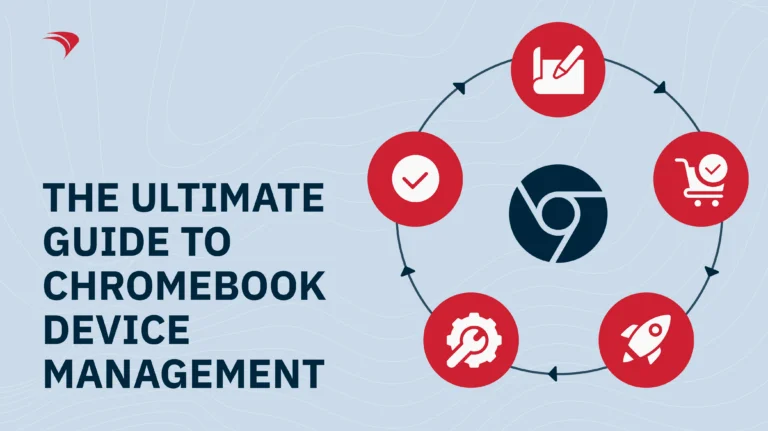If you’ve been researching device management solutions, you’ve probably seen the acronyms MDM (Mobile Device Management), EMM (Enterprise Mobility Management), and UEM (Unified Endpoint Management).
At first glance, they sound similar — but each approach represents a different stage in the evolution of how IT teams manage devices, security, and user access.
In this guide, we’ll break down what each one means, how they differ, and why UEM software is now considered the most complete and future-ready solution for businesses, schools, and government organizations.

Types of device management solutions
How MDM, EMM, and UEM Evolved
As workplaces became more mobile, organizations needed better ways to monitor, manage, and secure every device connected to their network. That’s where MDM, EMM, and UEM come in; each expanding on the other to meet modern IT challenges.
At a high level:
- MDM (Mobile Device Management) focuses on smartphones, tablets, and laptops.
- EMM (Enterprise Mobility Management) extends MDM with additional content and identity management features.
- UEM (Unified Endpoint Management) takes everything further, covering all endpoints — from PCs to IoT devices — in one unified platform.
Let’s take a closer look at each.
What is MDM? (Mobile Device Management)
Mobile Device Management (MDM) gives IT teams control and visibility over mobile devices such as smartphones, tablets, and laptops, whether company-owned or part of a BYOD (bring your own device) program.
Most MDM software supports major operating systems like macOS, Windows, iOS, iPadOS, Android, and ChromeOS.
With an MDM solution, IT teams can:
- Automate device setup with zero-touch enrollment and remote provisioning.
- Enforce security policies consistently across the entire device fleet.
- Restrict or whitelist apps, ensuring employees or students use only approved software.
- Remotely wipe or lock devices if lost or stolen.
- Monitor device health and usage to maintain performance and compliance.
Example: A school district can use MDM to manage hundreds of iPads, control what apps students can download, and quickly lock or reset devices remotely if one goes missing.
Also read: The Ultimate Guide to Windows MDM
What is EMM?
As mobile devices became central to the workplace, Enterprise Mobility Management (EMM) emerged to fill the gaps MDM couldn’t.
Early MDM tools didn’t support BYOD programs; a major challenge as employees started using personal devices for work. EMM software solved this by expanding functionality to include:
- BYOD support for managing both personal and corporate devices.
- Mobile Application Management (MAM) to control and distribute apps.
- Mobile Content Management (MCM) to securely handle company files.
- Identity and access management (IAM) to authenticate users.
- Compliance enforcement with data security policies.
In short, EMM combined MDM’s device-level control with stronger security and content management, paving the way for unified endpoint management (UEM).
MDM vs EMM: Is There Still a Difference?
Today, the distinction between MDM and EMM has blurred. Most modern MDM solutions already include the app, content, and identity management capabilities that were once EMM-exclusive.
In practice, the industry now uses “MDM” as a catch-all term for both. But the real leap forward came with UEM software, which took everything MDM offered — and unified it for every type of device and operating system.

What is UEM?
Unified Endpoint Management (UEM) is the next step in device management evolution. It builds upon MDM and EMM, allowing IT teams to manage, configure, and secure every endpoint, from mobile devices and PCs to IoT and wearable tech; all from one centralized dashboard.
A modern UEM platform helps IT teams:
- Manage every device and OS, including Windows, macOS, iOS, Android, ChromeOS, and Linux.
- Automate software deployment, patching, and compliance workflows.
- Use custom scripts and workflows to tailor management to specific needs.
- Protect against security risks with patch management and self-healing tools.
- Unify visibility across all assets, no matter where users are.
Example: A hospital using a mix of tablets, laptops, and IoT devices can manage all endpoints through one UEM console, ensuring data security, compliance, and uptime across departments.

How to choose the right device management software for your organization
When deciding between MDM vs UEM, start with your current setup and long-term goals.
Ask yourself:
- What types of devices do you need to manage — tablets, laptops, PCs, or IoT devices?
- How many operating systems do you support?
- Are you running a remote, hybrid, or in-person setup?
- Do you allow BYOD, or is your environment fully corporate-owned?
- What’s your IT budget and scalability plan?
If your organization only uses a single type of mobile device (e.g., iPads in a K–12 classroom), MDM software may be sufficient. But if you manage multiple OS types, endpoints, or require advanced automation and security, UEM softwarewill serve you better long-term.
Examples by Industry
MDM is ideal for:
- Schools managing tablets or Chromebooks for students, needing app restrictions and content management.
- Small businesses with a simple mobile fleet (like tablets in delivery vehicles) requiring geo-location and security controls.
UEM is best for:
- Educational institutions with a mix of tablets, smart boards, and PCs that need unified security policies.
- Enterprises or government agencies managing thousands of endpoints with complex compliance and cybersecurity requirements.
Pro tip: Even if you’re only using tablets today, choosing a scalable UEM solution ensures you’re ready as your fleet — and your organization — grows.
Why UEM is the superior device management solution
The Benefits of Unified Endpoint Management
There’s a time and place for MDM, but UEM software delivers long-term value for nearly every organization. Here’s why:
1. Manage All Devices from a Single Console
From smartphones and laptops to IoT devices and wearables, UEM provides cross-platform visibility and centralized control. IT teams no longer need to juggle multiple tools.
2. Stronger Security and Compliance
A unified environment means unified policies. UEM helps enforce consistent security standards, monitor compliance, and protect sensitive data across all devices.
3. Support for Multiple Operating Systems
UEM supports the widest range of operating systems, including macOS, Windows, Android, iOS, ChromeOS, and Linux, so IT teams can manage mixed environments easily.
4. Advanced Automation and Self-Healing
Modern UEM platforms like FileWave include self-healing technology that automatically repairs broken configurations, reinstalls corrupted software, and maintains system integrity without manual effort.
5. Infinite Scalability for Growing Organizations
As your business or institution expands, a UEM solution scales seamlessly, without adding new management layers or tools.
Stay on top of your devices with FileWave
If you’re looking for a unified endpoint management solution that’s flexible, scalable, and built for real-world complexity, FileWave has you covered.
With FileWave UEM, you can:
- Manage thousands of devices across all major operating systems.
- Automate software distribution and content delivery securely.
- Eliminate manual troubleshooting with self-healing and Booster technologies.
- Adapt to your needs with affordable, scalable pricing for any organization size.
Whether you’re managing a classroom of iPads, a global hybrid workforce, or a government network of secure endpoints, FileWave gives you complete control from one powerful platform.
Final Thoughts
The difference between MDM and UEM comes down to scale, control, and flexibility.
- MDM software is perfect for organizations that need to manage a smaller, mobile-focused device fleet.
- UEM software is built for those managing a growing, cross-platform ecosystem — where visibility, automation, and compliance are non-negotiable.
Modern IT needs one clear view of every device. That’s exactly what Unified Endpoint Management delivers.
Ready to optimize your device management? Try out FileWave for free.





